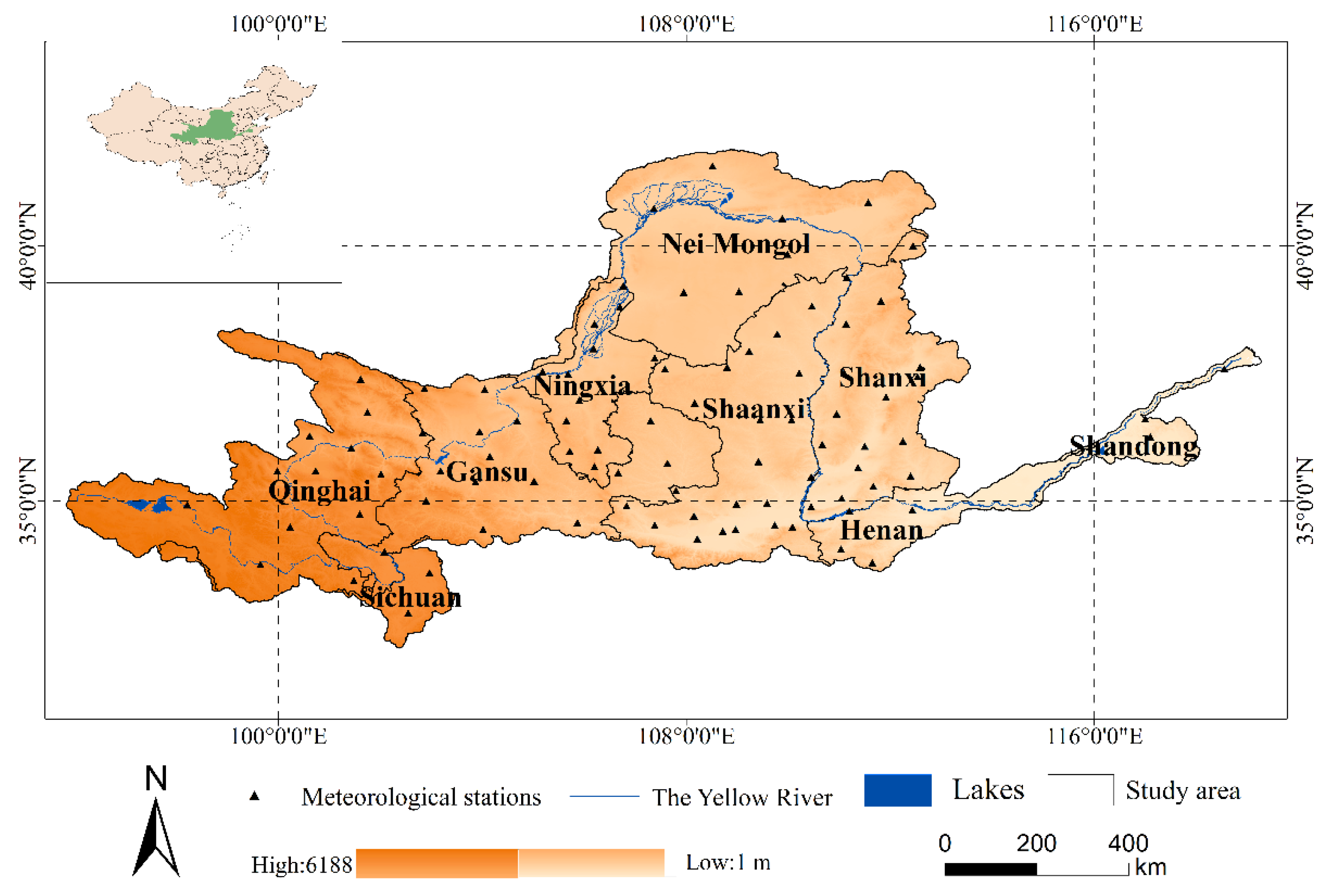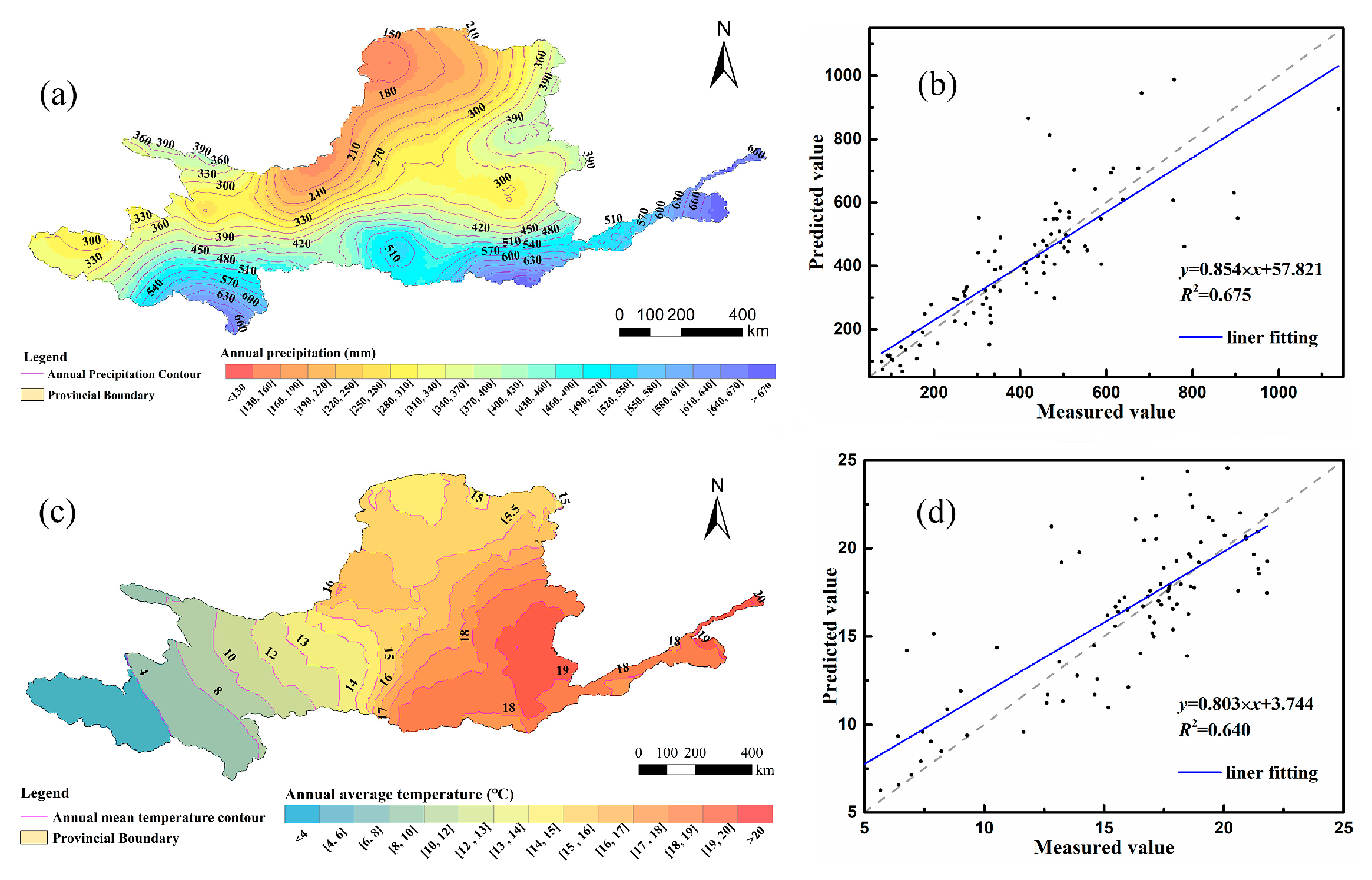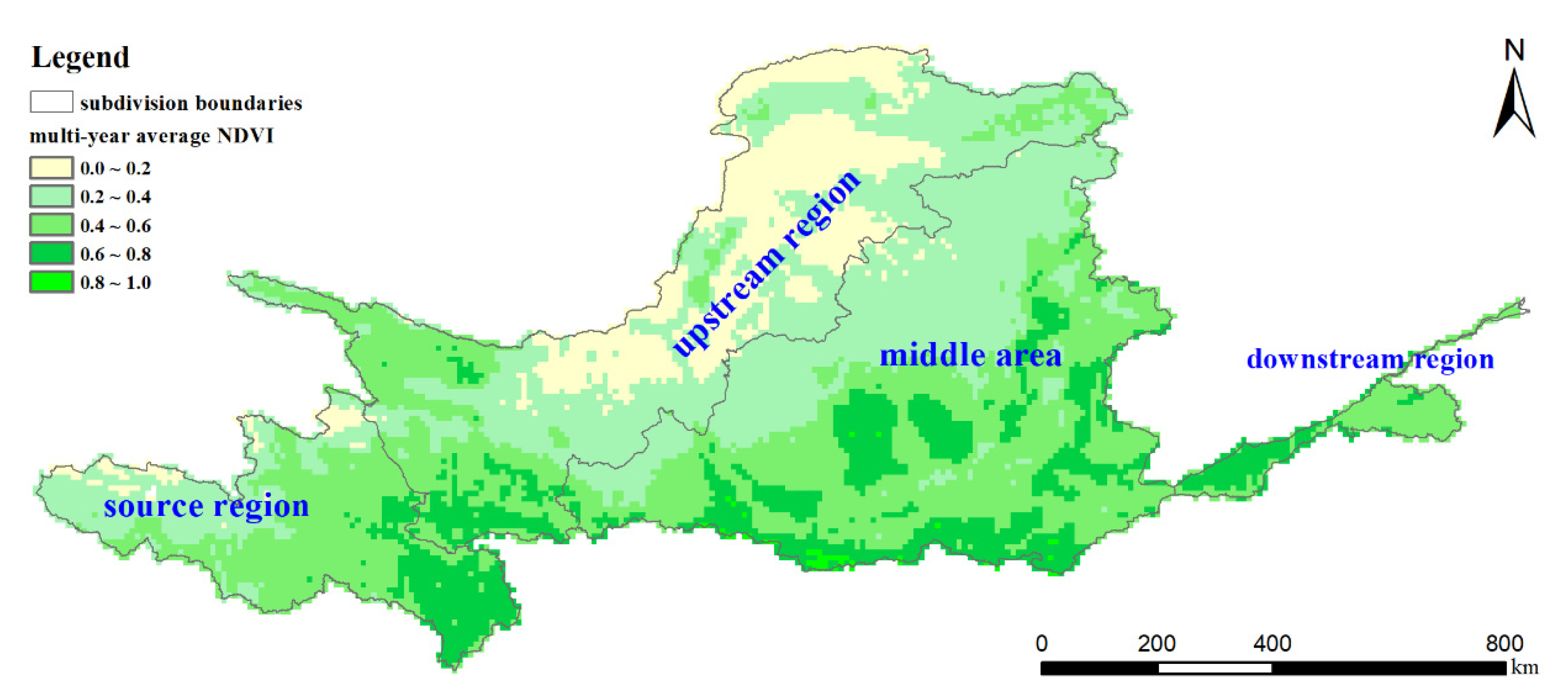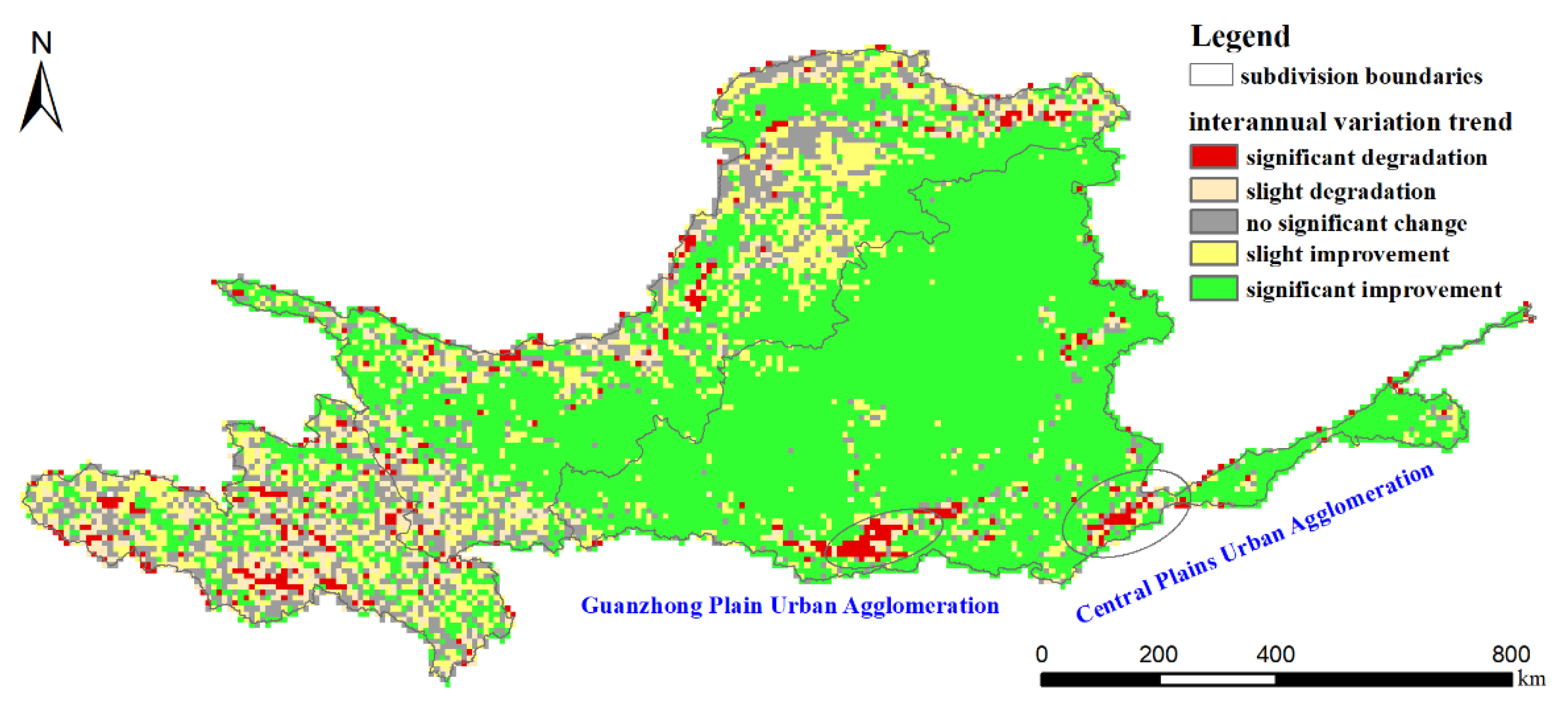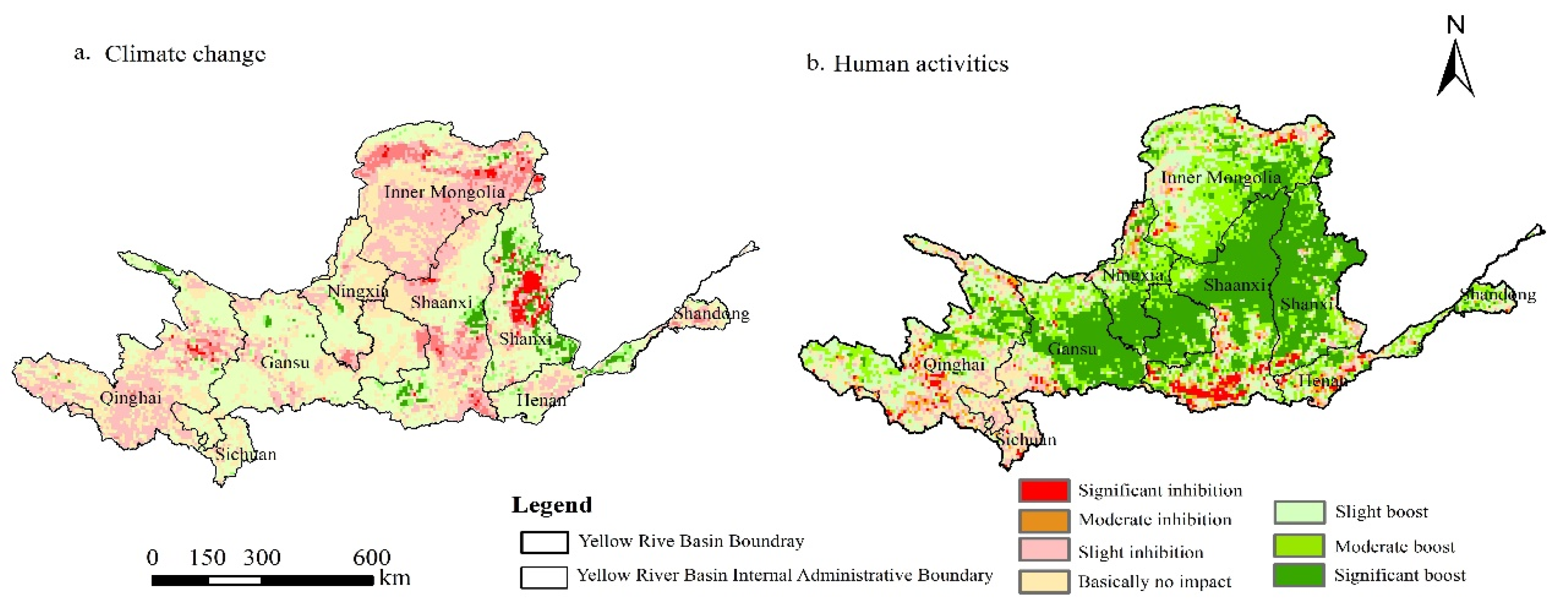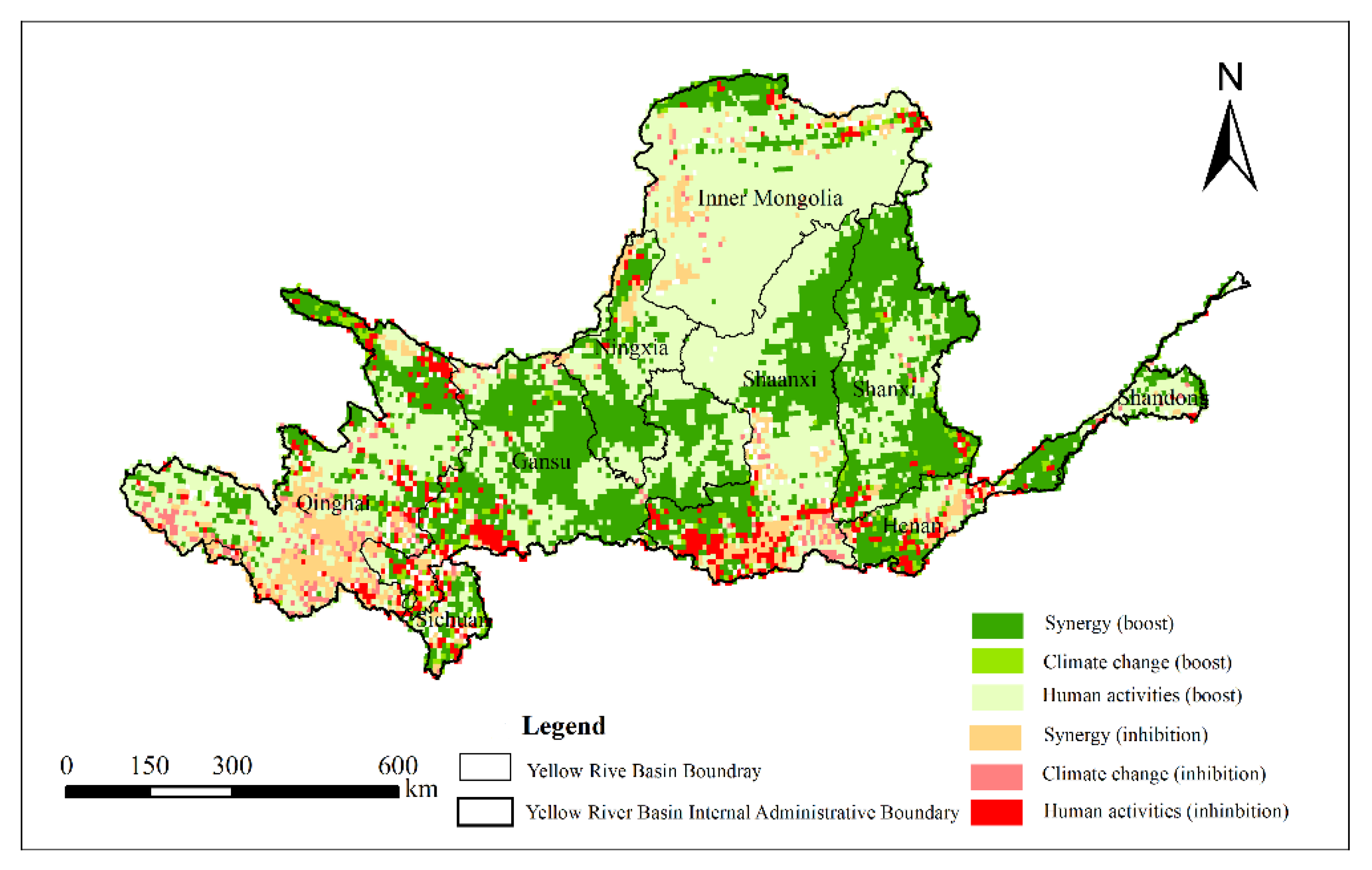1. Introduction
Vegetation is a crucial component of terrestrial ecosystems and plays an important role in terrestrial carbon balance and climate regulation [
1,
2,
3,
4]. The study on the dynamic change [
5,
6,
7], driving mechanism [
8,
9], and regulation of vegetation ecosystem [
10,
11] under changing environment is one of the core contents of global change research. Monitoring the vegetation dynamics and quantifying the impact of climate change and human activities on vegetation dynamics have important practical value for determining ecological engineering layout and management countermeasures and have become a research hotspot of sustainable management of vegetation ecosystems under the changing environment [
4,
7,
12,
13].
Normalized difference vegetation index (NDVI) is a commonly used remote sensing index to reflect vegetation dynamics [
14,
15,
16]. With the rapid development of geographic information technology, a large number of NDVI products have been produced. AVHRR NDVI [
17,
18], SPOT VGT NDVI [
19], and MODIS NDVI [
3,
20] are widely used global NDVI products. GIMMS NDVI 3 g dataset is based on the AVHRR sensor. The product covers the period from January 1982 to December 2015, with a spatial resolution of 8 km and a time resolution of 15 days [
18,
21,
22]. It is the NDVI product with the longest time series so far. SPOT VGT NDVI product covers the period from April 1998 to the present, with a temporal resolution of 10 days and a spatial resolution of 1 km [
19]. MODIS NDVI includes four NDVI products, namely, MOD13Q1, MOD13A1, MOD13A2, and MOD13A3. Their spatial resolutions are 250 m, 500 m, and 1 km, respectively, and their temporal resolutions are all 16 days [
23,
24,
25,
26]. The time series and spatial resolution of different products are also different, which can describe the spatiotemporal characteristics of vegetation coverage at different scales in different time periods [
18,
19,
23].
In recent years, a large number of scholars have carried out spatiotemporal variation and influence factors of vegetation cover based on the products mentioned above in different research areas [
27,
28,
29,
30]. Gu et al. explored the vegetation changes and influencing factors in the Red River basin from 2000 to 2014 based on MOD13Q1 NDVI data [
31]. The results show that both precipitation and temperature have time lag effects on vegetation change, precipitation has a greater impact on vegetation change than temperature, and the Grain for Green Project affects the temporal and spatial patterns of vegetation coverage. Gao et al. found that the annual and interannual NDVI changes in Mu Us sandy land are dominated by temperature and precipitation, respectively, and the impact of human activities on vegetation improvement in Mu Us sandy land is greater than in climate change [
32]. Taking the North China Plain as a study area, Duo et al. have carried out relevant studies and found that the effect of human activities in the vegetation degradation region is higher than that in the improvement region. However, after the climate abruptly changes, the conclusion is just the opposite [
1]. Zhang et al. found that vegetation improvement is mainly driven by climate change, and human activities have an inhibitory effect on vegetation growth in the Three-River headwaters region [
33]. In general, the characteristics and influence factors of vegetation cover change in different regions are quite different [
19,
31,
33].
The Yellow River, the second longest river in China and often named “the mother river of the Chinese nation”, plays an important role in China’s economic and social development and ecological security [
34,
35]. Due to the combined action of precipitation, evaporation, topography, and human activities, the ecological environment of the Yellow River Basin (YRB) is fragile; meanwhile, water and soil loss is serious [
36]. The YRB is the most important region of water and soil loss in China and even in the world, and the area of soil and water loss region accounts for 62% of the total area of the YRB [
35,
36]. The ecological protection and high-quality development of the YRB have become a major national strategy in China [
37]. Understanding the vegetation dynamics and its response to climate change and human activities in the YRB is of great application value for formulating reasonable ecological protection schemes. However, previous studies have often selected local regions of the YRB (such as the source region of the Yellow River, the Loess Plateau, and the Yellow River Delta, etc.), and the time span is mostly before 2015 at the scale of 8 km [
5,
11,
16].
Based on the above background, this study takes the whole YRB as the study area and researches the vegetation variation and its influence factors. The aims of this study are to (1) assess the spatial pattern and interannual variation of vegetation cover in the YRB over the period of 1982–2021 and (2) examine the influence factors of vegetation cover change in the YRB.
3. Methodology
Figure 2 shows the flowchart of this study, which mainly consists of the following four steps: (1) dataset preprocessing, including the NDVI dataset and the meteorological dataset; (2) data fusion, establishing a unary linear regression model and producing 8 km spatial resolution NDVI dataset of the YRB from 1982 to 2021; (3) spatiotemporal dynamic analysis, analyzing the spatial pattern and temporal change characteristics of vegetation cover in the YRB; (3) influence factors analysis, exploring the key driving forces affecting vegetation cover change.
3.1. Dataset Preprocessing
A series of preprocessing is performed on the GIMMS NDVI dataset and MOD13A3 NDVI dataset in this study, including projection transformation, format conversion, maximum value composite (MVC), and average calculation. This projection of the datasets is first defined as WGS84_Albers with the main parameters set as follows: central meridian is set to 115.0, and two standard parallels are set to 25.0 and 47.0, respectively. Then, monthly NDVI datasets are obtained using the MVC method to eliminate the influences of clouds, atmosphere, and solar altitude angle. Finally, the annual NDVI datasets are obtained by average calculation of monthly NDVI datasets of the growing season (April–October).
The meteorological datasets are also carried out through a series of preprocessing in this study. The cumulative precipitation and average temperature of each meteorological station from March to October are firstly calculated. Previous studies [
19] have indicated that precipitation and temperature have hysteresis effects on vegetation change; thus, cumulative precipitation and average temperature from March to October are calculated in this study to analyze the response of vegetation cover to climate change and human activities. The ordinary Kriging interpolation method is then used to obtain the spatially interpolated raster data of the cumulative precipitation and average temperature year by year with a grid size of 8 km. The first and second rows in
Figure 3 show the spatially interpolated raster data and the accuracy of the cumulative precipitation and average temperature in 2015, and the squared correlation coefficients between the measured and interpolated values of these two raster data are 0.675 and 0.640, respectively, which is calculated by the cross-validation method.
3.2. Data Fusion
This study focus on exploring the spatiotemporal variation characteristics of vegetation cover in the YRB at the 8 km scale. Therefore, the GIMMS NDVI dataset and MOD13A3 NDVI dataset are fused to generate an 8 km scale vegetation cover dataset in the YRB from 1982 to 2021. Specific methods and procedures are as follows:
- (1)
Resampling MOD13A3 NDVI. The bilinear interpolation method is used to resample MOD13A3 NDVI in the YRB from 2000 to 2021 to 8 km;
- (2)
Establishing a consistency correction model. The spectral resolution of different sensors is different. In order to maintain the consistency of the NDVI dataset generated by data fusion [
19], the resampled MOD13A3 NDVI should be corrected. Previous studies have shown that NDVI from different sensors has a certain linear correlation [
19]. Therefore, this study intends to establish a unary linear regression model pixel by pixel to correct the resampled MOD13A3 NDVI based on the resampled MOD13A3 NDVI and GIMMS NDVI from 2000 to 2015. The model is as follows:
where
and
represent the NDVI values with pixel
i year
d of the corrected MOD13A3 NDVI resampling data and resampled MOD13A3 data, respectively.
k and
b represent the slope and intercept of the model, respectively, which are estimated using GIMMS NDVI and resampled MOD13A3 NDVI from 2000 to 2015.
Figure 4 shows the correlation between measured (GIMMS NDVI) and predicted (corrected MOD13A3 NDVI resampling data,
) values, which are made using 2242 randomly selected sample points from 2000 to 2015. It is not difficult to find that the NDVI data (i.e., predicted NDVI) corrected by the linear regression model and GIMMS NDVI data (i.e., measured NDVI) have suitable consistency (
R2 = 0.987).
- (3)
Establishing an 8 km scale NDVI dataset for the YRB from 1982 to 2021. The above model is used to correct the resampling MOD13A3 NDVI data from 2016 to 2021 and then combined with GIMMS NDVI data from 1982 to 2015 to generate an 8 km scale NDVI dataset of the YRB from 1982 to 2021.
3.3. Spatiotemporal Dynamic Analysis
In this study, the Theil-Sen median trend analysis method (TSM) is used to analyze the change trend of vegetation cover in the YRB during 1982–2015, and the Mann–Kendall test method (MK) is used to test the significance of the change trend. The TSM is a robust non-parametric statistical trend analysis method, which can effectively reduce the interference of abnormal values [
3,
44,
45]. It is calculated by:
where
and
represent the NDVI values with years
i and year
j, respectively.
is the median of
n (
n − 1)/2 combinations and reflects the change trend of vegetation cover. When
, the vegetation cover shows an increasing trend and vice versa.
The MK is a non-parametric statistical test method used to test whether the trend of change is significant. The MK has the advantage that samples do not need to obey certain distributions and has a strong ability to resist outliers [
3,
44]. The calculation formula is as follows:
where
where
n represents the number of years in the study period, and it is equal to 34 in this study. sign() is a symbol function.
Z represents a statistic from a standardized normal distribution with a range of (
). For a given significance level
,
represents the change trend is significant in the level
. Confidence levels of 95% and 99% are used. According to the
and |
Z|, the change trend of vegetation cover is divided into five categories, as shown in
Table 1.
3.4. Influence Factors Analysis
Residual analysis is a widely used method to analyze the influence factors of vegetation cover change [
16,
46]. The difficulty of the method is to accurately predict NDVI value only affected by climate change. Since 2000, a series of ecological restoration programs (such as the afforestation project and the Grain for Green Program, etc.) have been implemented, and vegetation cover is significantly improved in the YRB. Compared with the study period after 2000, the impact of human activities on vegetation cover change during 1982–2000 is weak. Therefore, this study assumed that vegetation cover change during 1982–2000 is only determined by climate change. Based on the assumptions, this study uses annual NDVI as the dependent variable and average temperature and cumulative precipitation from March to October as independent variables to construct a bivariate linear regression model per pixel to predict the NDVI value only affected by climate change and explore the key driving forces affecting vegetation cover change. Specific steps are as follows.
- (1)
Building the bivariate linear regression model per pixel and predicting NDVI value (
NDVICC) only affected by climate change.
where
Tem and
Pre represent the average temperature and cumulative precipitation pre pixels from March to October, respectively.
a,
b, and
c represent the model parameters, which are obtained by least square fitting using data from 1982 to 2000.
- (2)
Predicting NDVI value (
NDVIHA) affected by human activities.
where NDVI indicates the annual NDVI value of each pixel.
- (3)
Exploring the influencing factors of vegetation cover change.
Firstly, the unary linear regression analysis method is used to calculate the slope of the trend line of the interannual variation of
NDVI,
NDVICC, and
NDVIHA pixel by pixel. The calculation model is as follows:
where
represents the slope of the trend line of data series A. When A is NDVI,
NDVICC, and
NDVIHA data series, the slope of the trend line is
,
and
, respectively.
N represents the annual span in the study period, and this study analyzes the influencing factors of vegetation cover change from 2000 to 2021, so
n is set to 22. According to
,
, and
, the influencing factors of vegetation cover change in the YRB are divided into six categories, as shown in
Table 2.
5. Discussion
In this study, vegetation cover change characteristics over longer time periods are analyzed by fusing the GIMMS NDVI dataset and MOD13A1 NDVI dataset. The results show that (1) the temporal variation characteristic of vegetation cover in the YRB has obvious spatial heterogeneity, and the overall trend is fluctuating upward. (2) Vegetation cover increases gradually from northwest to southeast. These results are basically consistent with the conclusions of previous studies [
46,
47]. Compared with the annual growth rate of vegetation cover in different periods, the rate during 1982–2021 (0.019/10a) is slightly higher than that during 1982–2015 (0.015/10a), indicating that the growth rate of vegetation cover increase during 2016–2021.
Human activities have both positive and negative effects on vegetation cover restoration [
23,
27]. For example, urban construction and reservoir storage lead to the change of land use type from forest, grassland, and farmland to impervious surface or water. Overload herds cause large areas of grass to be eaten. All of these human activities have resulted in the reduction in vegetation cover. In addition, ecological protection measures such as afforestation and animal husbandry control have increased vegetation cover area. Vegetation cover has been significantly improved in the Loess Plateau with the implementation of a series of ecological protection policies, such as afforestation and returning farmland to forest. In general, this study concludes that the positive effects of human activities in the YRB are greater than the negative effects, indicating that a series of ecological protection policies in the YRB is effective.
This study analyzes the key driving forces affecting vegetation cover change, which has important reference significance for formulating scientific and reasonable ecological and environmental protection measures in the YRB. However, this study still has the following two shortcomings: (1) lack of in-depth analysis of the influence mechanism of climate change factors (precipitation and temperature) on vegetation cover change. (2) Lack of detailed analysis of the impact of different human activities (such as population growth, urbanization, agricultural development, and ecological protection policies) on vegetation cover. Solving the above shortcomings will help to deeply understand the influencing mechanism of vegetation cover change in the YRB, which is the follow-up content of this study.
